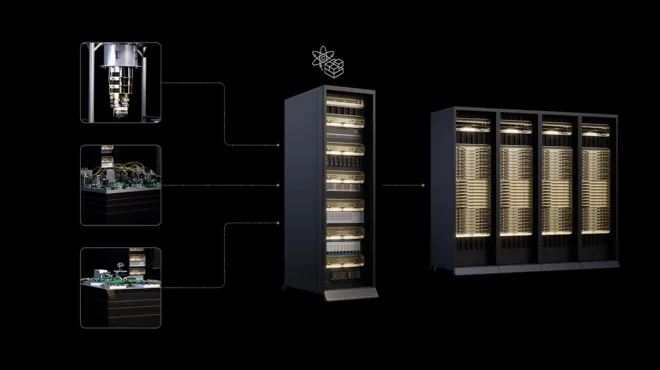NVIDIA cuQuantum is an SDK of libraries for accelerating quantum simulations at the circuit (digital) and device (analog) level. It is now integrated into Quantum Toolbox in Python (QuTiP) and Superconducting Qubits (scQubits), enabling end-to-end acceleration in workflows for designing and studying novel types of qubits.
QuTiP is a widely used package for simulating the time evolution of open quantum systems. scQubits is the most popular package for modeling superconducting qubits. Together, these packages enable users to define the parameters of novel qubit systems and evolve them in response to control pulses. Users can study their interactions with components such as filters or resonators. They can also calculate critical system parameters, such as frequency shifts and transition energies. This enables rapid prototyping of novel device designs to improve quantum device performance.
QuTiP is faster and more scalable with cuQuantum
Researchers in Alexandre Blais’ group at the University of Sherbrooke led the way, developing and integrating a new cuQuantum plugin for QuTiP, qutip-cuquantum. The technology delivers a 4000x speedup from CPU to an 8x GPU node hosted on AWS for a large transmon-resonator system. The QuTiP community can use the plugin to achieve top performance at scale, which leads to less noisy systems, addressing one of the key bottlenecks to scaling useful quantum computers.
The qutip-cuquantum plugin also supports the scaling of simulations to much larger Hilbert spaces with multi-GPU and multi-node capabilities, enabling the study of more complex quantum systems. Blais’ group also scaled to much larger systems (64-state transmon qubit / 512-state resonator pair), with the help of the P5en instance on AWS, simulations that were too large to run without multi-GPU support.

Anyone interested in QuTiP simulations at scale can now use cuQuantum on AWS for great performance in quantum dynamics simulation workloads. This enables QPU designers and researchers to understand how more complex dynamics affect their qubit designs.
scQubits is faster than ever with cuQuantum
Jens Koch’s group at Northwestern University is the developer of scQubits, an open source Python package for modeling superconducting qubits. Working with scQubits, NVIDIA developed APIs in cuQuantum that accelerate this package for executing the critical parts of the full qubit design workflow on NVIDIA GPUs.
Eigensolvers enable the computation of the energy spectra of superconducting devices, an important quantity necessary to design new types of qubits. scQubits provides a simple way for researchers to compute energy spectra given the physical parameters of a superconducting circuit, for example, the capacitance and inductance of various circuit components.

The outputs of scQubits can also easily serve as inputs for analog quantum dynamics simulations using QuTiP-cuQuantum. Designers can develop new quantum devices with improved coherence times, gate and readout performances, greater throughput, and fewer limitations on accessible system sizes by using GPU acceleration of scQubits and QuTiP with NVIDIA hardware and software.

With multi-GPU multi-node execution in both tools, Koch’s group can explore more complex composite qubit systems beyond just the single-qubit unit cell of a fluxonium (or other circuit) and a resonator.
Other developers will soon be able to scale their scQubits and QuTiP simulations up to previously out-of-reach lattices of multiple degrees of freedom to understand how multiple qubit systems interact with each other.
Getting started with QuTiP, scQubits, and NVIDIA cuQuantum
Download the GPU-accelerated QuTiP to enable your workloads on NVIDIA hardware by installing from PyPI with pip install qutip-cuquantum.
scQubits will soon support cuQuantum, enabling more than an order of magnitude speedup over CPU and scaling to regimes previously intractable.
cuQuantum 25.09 is out and enables these workflows with best-in-class performance and scale, ensuring that quantum device designers are getting the right answers faster than before, reducing the timeline to useful quantum computers. Download the cuQuantum SDK. The latest packages can be found on PyPI or Conda, and can be installed by pip install cuquantum-python-cu13.









